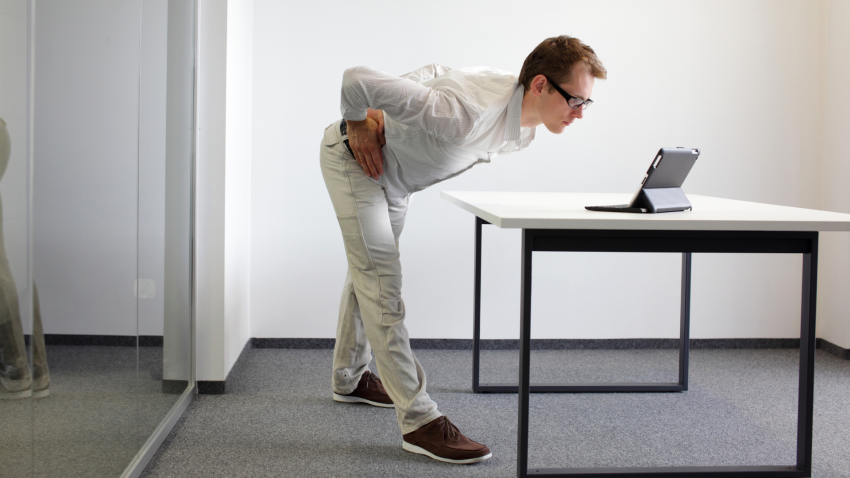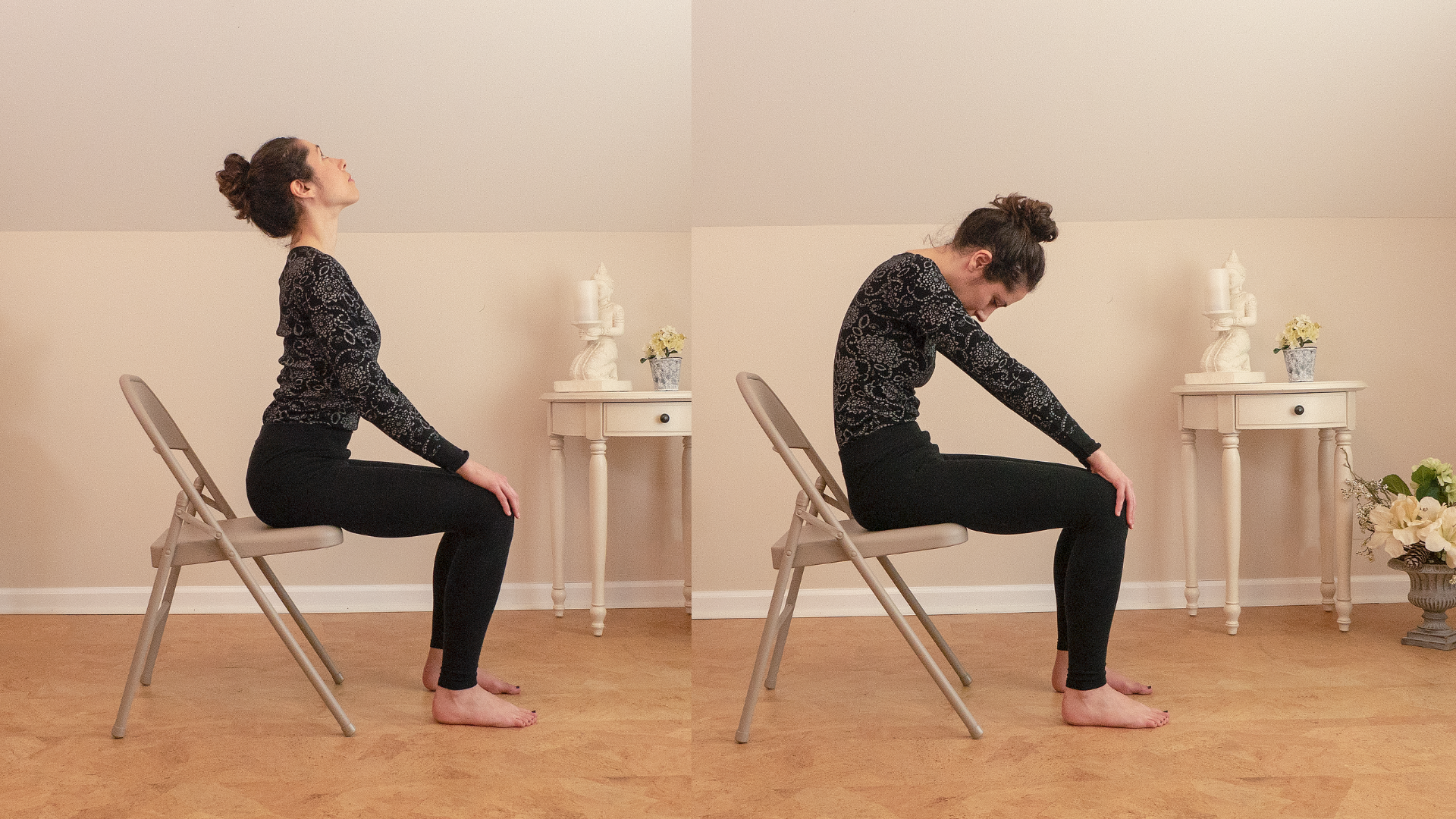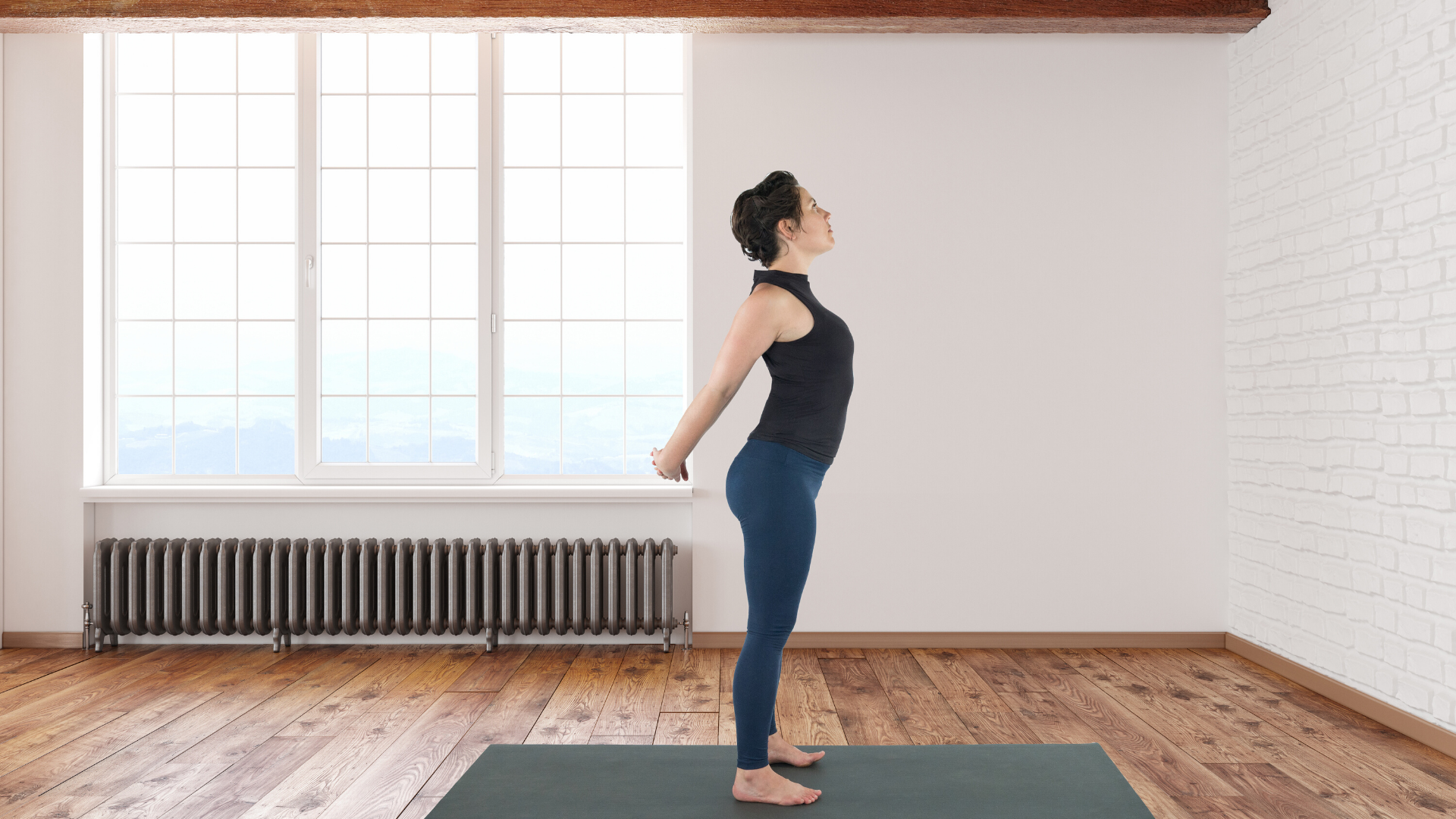View basket (0 items $0.00)

Easy Does It: Gentle Yoga for Workplace Back Care
Back pain. I hear about it all the time as a yoga instructor and as a person out there in the world. Back pain can be diffuse or sharp, in the upper or lower spine, related to sciatica or tight shoulders (amongst other causes). It’s become a frequent cause of calling in sick to work, outnumbered only by the common cold. Sedentary lifestyles, and for some people, combined with quick bouts of intense exercise after work hours, are one of the root causes.
What’s mostly happening here is the spine getting thrown out of its natural curvature for extended periods. A typical example is sitting with faulty ergonomics and or a slumped posture, with little to no interspersed movement. Faulty movement patterns in those intense exercise periods can only exacerbate the muscular strain that results from those conditions.
How we structure our work habits and environments, on a society-wide level, is no small or easy thing to change. Yet yoga can make a difference by counteracting those patterns and therein alleviating some of the pain. Let’s take a look at a quick yoga sequence to ease back pain. If you have an hour or two for the gym after work, you have five to ten minutes for this sequence!
Bonus: it can be done in almost any office space or other small room. Okay, you might fear your co-workers will think you’re strange for practicing yoga at your desk, but maybe, just maybe, they’ll feel inspired to do so themselves!
Seated Marjaryasana/Bitilasana (Cat/Cow) Flow

This flow warms up the spine for more in-depth work to come. It loosens tight back/trunk muscles and attunes us to our natural spinal curves.
-
Sit on the front edge of a chair, feet planted in front of you at hips-distance apart. Your knees should be approximately the same height as your hips. If they are not, if possible, adjust the height of your chair.
-
Tune into your breath: is it rhythmic and deep, full but easy? Notice if you might be holding any tension in your face, and try to release it on your exhalation. Soften your gaze.
-
On an inhalation, reach your heart up to the sky. Let your head and neck follow the natural curvature of your spine. This is your Seated Cow Pose. Enjoy the stretch and openness coming from this motion.
-
On an exhalation, gently shift your pelvis such that your spine curves in the opposite direction. Let your chin fall toward your chest. Let your shoulders release to follow the motion of your spine here. This is your Seated Cat Pose.
-
Repeat that sequence 10 to 15 times.
-
Take a few breaths, perhaps noticing any change in the quality or pace of your breathing. If it’s comfortable for you, close your eyes to help turn your focus inward.
Wall Adho Mukha Svanasana (Downward-Facing Dog Pose)

This pose stretches the entire spine, along with directly connected areas such as arms, glutes, and hips. It also promotes core strength, which is essential for back health.
-
Stand facing a wall, at arms-distance away. Check-in with your breath. Notice any tension, and try to release it on your exhalations.
-
Place your hands on the wall at shoulder height, spreading your fingers wide and pushing evenly into each finger and heel of your hand.
-
From there, walk your feet back so that you can stretch such that your spine becomes a diagonal line. Let your neck stay in line with your head so that you end up looking down at the ground.
-
Feel your spine lengthen toward the wall, but also toward your hips, creating dynamic space between each vertebra.
-
Stay here for 5 to 15 breaths, breathing rhythmically and deeply.
-
If it feels good, pedal your feet (just like you might if you were doing regular Downward-Facing Dog Pose). If not, stay in dynamic stillness.
-
Come out of the pose by lifting your head so that you look forward. Let your hands release from the wall, and your arms fall naturally. Do any other movements that feel good here.
Clasped Hands Dance and Closing

This pose brings breath, stretch, and twist through the spine; stretches out the shoulder girdle area to address back pain coming from tightness there; and offers a sense of release, breath, and calm.
-
From standing, with a couple of feet of clear space ahead of you, interlace your fingers behind your back. For joint stability, touch your palms together and keep them that way for the rest of the sequence.
-
Check-in with your breath and try to release any tension that you may feel. Let your shoulders soften downward and backward.
-
On a breath in, lift your heart and try to lengthen up through your spine. On a breath out, fold forward at your hips. Feel your collarbones full of breath and broadness.
-
Straighten (but don’t lock) your left knee, and bend your right knee. Take your left shoulder toward your right knee, so that you are twisting to the right. Hold for 5 to 10 breaths.
-
Practice the twist on the other side (right knee straightened and left bent, right shoulder toward the left knee) for the same number of breaths.
-
Sway back and forth for a few breaths, or longer, if your body asks for that. Release the clasp of your hands whenever it feels right for you, and let your arms release downward.
-
Take any other movements that feel good here. Feel your back spacious, open, and released.
-
If you haven't already, slowly rise to stand. Lifting with a flat back, core mildly engaged, is best for your spine.
-
Notice your breath: is it rhythmic and full? Soften your gaze or even close your eyes.
-
Stress and other negative emotions can exacerbate pain, so take a mindful moment here (applying a favorite meditation technique or simply listening to your breath). When ready, open your eyes (if closed), and proceed with your day with less pain and more ease.
 Kathryn Boland is an RCYT and R-DMT (Registered Dance/Movement Therapist). She is originally from Rhode Island, attended The George Washington University (Washington, DC) for an undergraduate degree in Dance (where she first encountered yoga), and Lesley University for an MA in Clinical Mental Health Counseling, Expressive Therapies: Dance/Movement Therapy. She has taught yoga to diverse populations in varied locations. As a dancer, she has always loved to keep moving and flowing in practicing more active Vinyasa-style forms. Her interests have recently evolved to include Yin and therapeutic yoga, and aligning those forms with Laban Movement Analysis to serve the needs of various groups (such as Alzheimer’s Disease patients, children diagnosed with ADHD, PTSD-afflicted veterans - all of which are demographically expanding). She believes in finding the opportunity within every adversity, and doing all that she can to help others live with a bit more breath and flow!
Kathryn Boland is an RCYT and R-DMT (Registered Dance/Movement Therapist). She is originally from Rhode Island, attended The George Washington University (Washington, DC) for an undergraduate degree in Dance (where she first encountered yoga), and Lesley University for an MA in Clinical Mental Health Counseling, Expressive Therapies: Dance/Movement Therapy. She has taught yoga to diverse populations in varied locations. As a dancer, she has always loved to keep moving and flowing in practicing more active Vinyasa-style forms. Her interests have recently evolved to include Yin and therapeutic yoga, and aligning those forms with Laban Movement Analysis to serve the needs of various groups (such as Alzheimer’s Disease patients, children diagnosed with ADHD, PTSD-afflicted veterans - all of which are demographically expanding). She believes in finding the opportunity within every adversity, and doing all that she can to help others live with a bit more breath and flow!
Featured Courses









